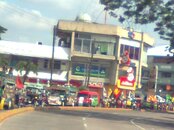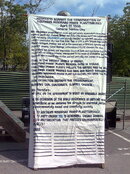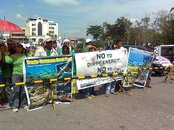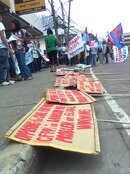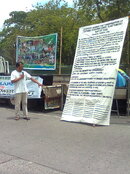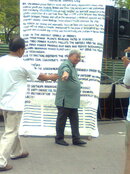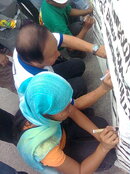From the Philippine Daily Inquirer, 22 March 2009.....
CORAL REEFS The ÅÓainforests of the sea, according to environmentalists are the most diverse, the most beautiful, and the richest of all marine habitats. They serve as natural barriers, protecting shorelines and reducing erosion from the vicious pounding of waves and storms.
But only a few people are paying attention to the coral reefs protection and preservation despite their vital role in the marine ecosystem, according to Reef Check, the worldÃÔ largest reef conservation organization.
In its September 2007 report, the Reef Check found that only five percent of the coral reefs in the Philippines the second largest in Asia were in ÅÆxcellent condition. These were the Tubbataha Reef Marine Park in Palawan, Apo Island in Negros Oriental, Apo Reef off Puerto Galera town in Mindoro, and the Verde Island Passage off Batangas.
Add Sarangani Bay to the other reefs where wanton destruction has remained unchecked. Although then President Fidel V. Ramos declared Sarangani Bay a protected seascape in 1996, divers claimed that more than half of the coral reefs in its 230-kilometer coastline were not just in bad shape but were almost wiped out.
Barely surviving
Chris Dearne, an English dive instructor, reveals that only the coral reefs in the western part of the bay, from the coastal village of Bawing in General Santos City up to Maitum town in Sarangani, are still intact.
From the shores of Tambler village in General Santos going eastward to the towns of Alabel, Malapatan and Glan in Sarangani, only small patches or about 10 percent of the reefs are barely surviving.
Recently, Dearne and other diving enthusiasts checked the status of the coral reefs.
ŵhe eastern side has been the hardest hit as pesticides, chemicals and pollutants from the farming and industrial communities found its way into the bay, he says. Unless these harmful activities are stopped, he says, it may just be a waste of time to try to rehabilitate the damaged reefs.
Dearne further notes that siltation caused by unabated cutting of trees in the mountains of Alabel and Malapatan for lumber and charcoal production has been wreaking havoc on the coral reef off Alabel. This was exacerbated by the presence of aquaculture farms.
ŵhousands of fish and shrimps contained in land-based and floating fish cages undergoing rapid growth treatments all have to go to the bathroom on a regular basis, thus creating an excess of nutrients in the water causing algae to bloom and cover the corals, Dearne says.
Illegal fishing
During several dive outings, Dearne, who owns the Tuna City Scuba Center and Cambridge Farm-Hotel in General Santos, and John Heitz, an American businessman engaged in tuna export, noticed that illegal fishing methods had damaged the reefs in the western side of the bay.
Since government agencies and the people tasked with protecting the delicate marine environment were not doing anything to check the reef destruction, Dearne and Heitz thought of a private-sector initiative to save the reefs. Thus, the idea of an artificial reef dome was spawned.
On April 1, 2005, the man-made reef dome named Ťambridge was built. The Mushroom, Fish Port, Makar and other artificial structures followed, differing in size, shape and design.
Each dome, made from locally available materials, such as cement, steel bars, sand and gravel, bamboo slats, oil and wire, cost only about P200.
With the help of local divers, Dearne set up the first five Reef Domes off Maharlika Beach Resort in Bawing, General Santos, on April 17, 2005. The resort is also used by the Englishman for his dive training.
Å°nce a dome is installed on a damaged or barren section of a reef, it acts as a stable platform for free floating organisms to attach themselves and after just a short period of time, tiny marine creatures will start to grow on its surface, Dearne said.
Holes in the structure allow fish and other marine creatures to seek sanctuary from predators.
5,000 manmade domes
In three years, Dearne and Heitz, along with other divers and sponsors, deployed 5,000 artificial reef domes in 20 areas in the western coast of the bay. The project was completed in August last year, but maintenance and monitoring dives continued.
Dearne says the project cost around nearly P1 million, excluding expenses for work dives and diving gear, transport and documentation. ŵhe total amount would at least be double or more, he says.
The project completion report noted that ÅÐn occasions, within the first 24 hours of deployment, the clean surfaces of the reef domes have been covered with fish eggs. Many reef domes have resident lion fish or moray eels, which use the reef domes as traps to catch smaller prey fish.Æû/p> Right now, Dearne says, several corals are naturally-growing on submerged domes.
Ůany varieties of soft coral colonize the reef domes along with barnacles and other types of permanent shelled organisms. We actually thought that it would take many years for hard corals to show themselves. We were very surprised to see that it only took less than nine months or so for these hard corals to start to show their true form, Dearne says.
In one site in Takut Tabo in Bawing, coral growth was faster with huge Acropora corals covering many reef domes, he says.
The divers observed that fish populations had dramatically increased in Sarangani Bay. They suggested that fishermen should go back to the traditional ÅÉook-and-line method instead of using fine-meshed net.
Bigger threat looms
Harmful fishing practices, along with climate change, are threatening the residual coral reefs and artificial reef domes. Local governments around the bay are now rallying behind the project and strictly implementing fisheries and environmental laws.
A few years ago, the provincial board adopted a resolution declaring persona non grata a certain Ma. Theresa Garay, a city employee involved in the Ŭagandahan Gensan project, for illegally collecting corals from Tinoto Beach in Maasim. Mayor Pedro Acharon Jr. suspended Garay for one month to show that he was not condoning any wrongdoing of his employees.
Sarangani has since projected an image of a no-nonsense protector of the environment. It has launched the Sarangani Bay Festival to raise peopleÃÔ awareness about the utmost importance of conserving the bay.
Now comes another challenge to the province with the construction of a 200-megawatt coal-fired power plant.
Dearne and Heitz fear that the $450-million Kamanga Power Plant (KPP), once it operates, will inflict extensive damage not just on the coral reefs and dive sites but also on the environment and public health.
Officials of Conal Holdings Corp. (CHC), the main proponent, however, say that the company would employ the circulating fluidized bed combustion (CFBC) process, considered the ÅÎost efficient and cleanest among available coal-powered plant technologies in the industry today.
In a statement, Joseph Nocos, CHC vice president for business development, said that the company would embark on a ÅÎassive planting of trees in a 10,000-hectare land identified as a carbon sink.
Aquaculture farms
Heitz, a former US Peace Corps volunteer, told Conal Holdings to leave the diving sites alone and find another place for its plant. Dearne dared the company to put up the facility side by side with the sprawling aquamarine farms of the Alcantara family in Alabel if it believes that it is ÅÓeally environmentally safe.Æû/p> The Alcantaras are among the shareholders of Sagittarius Mines Inc. (SMI) that is exploring for copper and gold deposits in the mountains of Tampakan, and Sultan Mining & Energy Development Corp., which is engaged in coal exploration in the hinterland of Lake Sebu town, all in South Cotabato.
Sarangani Governor Miguel Dominguez, a scion of the Alcantaras, has expressed full support for the coal-fired plant.
ŵhe Kamanga Power Plant is primarily intended to serve the power requirements of mining projects in the region, not for households, Heitz says.
He likens the coal-fired plant to a car, saying ÅÕhere can be no smoke emission, but itÃÔ still releasing gaseous substance into the environment.Æû/p> He challenges the power industry players to tap renewable energy sources instead.




